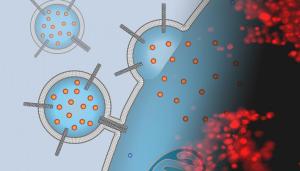LAB REPORT
Science and Technology Making Headlines
May 7, 2021


Predatory bacteria — bacteria that eat other bacteria — use approaches remarkably similar to much larger organisms as they target their prey. Image courtesy of Northern Arizona University.
Taking a bite out of their own
Nestled into the soil, at scales too tiny to see without a microscope, intricate communities of microorganisms are hard at work — eating, reproducing and killing each other.
As it turns out, bacteria that feed on other bacteria are surprisingly common in soil ecosystems.
Predators aren’t always your typical lion or falcon, living in food webs that are visible to humans, explain the authors of new research.
Sometimes they’re miniscule bacteria, hunting in dramatic “wolf-pack”-like formations underground. Often too small to fully “engulf” their prey, as the authors put it, “they consume them no less ferociously.” One type of soil bacteria, the appropriately named Vampirovibrionales, “drills a hole in its host” — using what are essentially fangs — “and sucks out the juice,” says coauthor Jennifer Pett-Ridge, a senior staff scientist at Lawrence Livermore National Laboratory.

Rare-earth oxides (clockwise from top center): praseodymium, cerium, lanthanum, neodymium, samarium, and gadolinium. Image courtesy of Peggy Greb/USDA.
A rare find
Some rare earths can make things glow in the dark (strontium aluminates), some are supermagnetic (neodymium), some are radioactive (promethium). They’re used in cancer treatment, electric engines, telescope lenses, TVs, cellphones and fighter jets. And many are extracted and refined almost entirely in China.
Ironically, rare earths aren’t actually rare in most cases, they’re just difficult and expensive to extract and purify.
“We call them rare earth, but we produce a lot of them,” said Gauthier Deblonde, a scientist at Lawrence Livermore National Laboratory in the nuclear and chemical sciences division. “Global production is about 250,000 tons, so if you compare them to something actually rare, like gold, we produce about a thousand times more rare earths than gold every year. The name is very misleading.”


An artist’s depiction of a liposomal drug carrier studded with carbon nanotube porins that is docking to a cancer cell surface and delivering chemotherapy cargo with a fluorescence microscopy image of stained cells exposed to these carriers. The red stain indicates that the cells are dead and the treatment was successful. Images by P. Lastrico of MPI and N.T. Ho and A. Noy of LLNL.
Drug delivery STAT
Modern medicine relies on an extensive arsenal of drugs to combat deadly diseases such as pneumonia, tuberculosis, HIV-AIDS and malaria. Chemotherapy agents have prolonged lives for millions of cancer patients, and in some cases, cured the disease or turned it into a chronic condition.
But getting those drugs into disease-ridden cells has remained a major challenge for modern pharmacology and medicine. To tackle this difficulty, Lawrence Livermore National Laboratory and University of California Merced scientists and collaborators from the Max Planck Institute have used carbon nanotubes to enable direct drug delivery from liposomes through the plasma membrane into the cell interior by facilitating fusion of the carrier membrane with the cell.
Drugs are often poorly soluble, strongly toxic to other tissues or face rapid degradation in the different chemical environments in an organism. They can accumulate in non-target tissues, bind to other cellular components or may not internalize efficiently into the target cells. Liposomal delivery systems aim to mitigate these problems by encapsulating drugs in external carriers that circulate through the bloodstream. However, these systems involve a trade-off between enhancing liposomal stability on the way to the target and easing payload release into the cytosol of the target cell.
"We thought that carbon nanotube porins — short pieces of carbon nanotubes inserted into lipid membranes — can mimic viral fusion peptide functionality and help to fuse the liposomal carriers to the membranes of cancer cells," said scientist Alex Noy, who led the research at LLNL.


From left, are LLNL postdoctoral researcher Dan Milroy and computer scientists Stephen Herbein and Dong H. Ahn are working on the system.
Practice makes perfect
Lawrence Livermore, IBM and Red Hat are combining forces to develop best practices for interfacing high-performance computing (HPC) schedulers and cloud orchestrators, an effort designed to prepare for emerging supercomputers that take advantage of cloud technologies.
Under a recently signed memorandum of understanding, researchers aim to enable next-generation workloads by integrating LLNL’s Flux scheduling framework with Red Hat OpenShift — a leading enterprise Kubernetes platform — to allow more traditional HPC jobs to utilize cloud and container technologies. A new standardized interface would help satisfy an increasing demand for compute-intensive jobs that combine HPC with cloud computing across a wide range of industry sectors, researchers said.
“Cloud systems are increasingly setting the directions of the broader computing ecosystem, and economics are a primary driver,” said Bronis R. de Supinski, chief technology officer of Livermore Computing at LLNL. “With the growing prevalence of cloud-based systems, we must align our HPC strategy with cloud technologies, particularly in terms of their software environments, to ensure the long-term sustainability and affordability of our mission-critical HPC systems.”


NIF’s high-energy laser beams converge on a target at the center of the target chamber. Success in achieving fusion ignition would be a major step forward in the pursuit of safe, carbon-free fusion energy.
Pushing for fusion
An influential Department of Energy (DOE) advisory committee has recommended that the nation move aggressively toward the deployment of fusion energy, including investments in technology and equipment to support one of the core missions of LLNL’s National Ignition Facility (NIF) — laying the groundwork for the development of inertial fusion energy (IFE).
The report, two years in the making, provides a decade-long vision for U.S. fusion energy and plasma science under the DOE Office of Science’s Fusion Energy Sciences (FES) program. NIF&PS physicist Tammy Ma, a member of FESAC and the report subcommittee, said LLNL was a major participant in the plasma physics community planning process that laid the foundation for the report’s 10-year strategic plan.
The report notes the “enormous progress” NIF has made toward ignition. The report calls for partnerships with federal, international and private investors and outline opportunities for growth in fusion and plasma research, which NIF is intently pursuing.
“FES historically has funded the magnetic fusion energy research in the U.S., previously funded IFE and supported the academic high energy density physics research in the U.S.,” Ma said. “While the total funds LLNL receives each year from FES is small compared to what we receive from NNSA (the National Nuclear Security Administration), the path that FES charts has always had a significant influence on the trajectory of fusion and plasma research at the Lab.”





